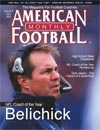The Swedish Airforce
The Bethany College Swedes from Lindsborg, Kansas go to the air to set up the ground game.
by: Dustin MillerOffensive Coordinator, Bethany College©
More from this issue
When head coach Dr. Ted Kessinger
arrived at Bethany College 26 years ago, he brought an offensive
philosophy in which the pass will set up the run. During this time
period the Swedes have relied on the passing game to move the football.
The offensive philosophy at Bethany College is based on the following
ideas:
1. Always attack - we must have the attack mentality on offense
and set the tempo.
2. Balance between run and pass - equally productive when used,
not necessarily 50% run and 50% pass.
3. Multiple formations/personnel groups - allows the offense to
get possible advantages of numbers, angles and athletes.
4. Shifting and motion - make the defense think and adjust instead
of just reacting.
5. Stretch the field both vertically and horizontally - must attack
the whole field.
6. Have the flexibility to get out of bad plays and into good plays.
7. Unpredictability - the essence of the entire offensive system
put together.
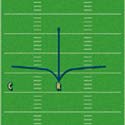
Diagram 1
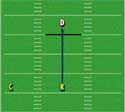
Diagram 2
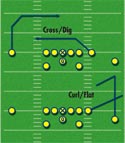
Diagram 3
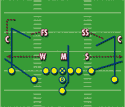
Diagram 4
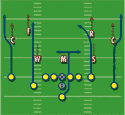
Diagram 5
|
8. Word efficiency with formations, motions, plays - ability to
say a lot by using very few words.
9. Flexible system - be able to adapt to personnel changes.
10. Teaching the offense - coaches and players must have an understanding
of the objective that is to be accomplished with each play.
The area of the Bethany College offense that will be discussed
in this article is the ability to stretch the field both horizontally
and vertically with a vertical release by deployed receivers. In
essence, a deployed receiver has three ways to attack the defense
at the snap; vertically, to the inside on a crossing type route
or outside on a route to the flat (Diagram 1). The only release
that allows the receiver to give the defender a three way go, and
not give any indication of the route or pattern, is the vertical
release (Diagram 2). Defensive coaches are doing an excellent job
in teaching pattern read concepts to defenders in which the crossing
route and flat route give the defense a quick read on the potential
pattern that will need to be defended (Diagram 3). The vertical
stem in routes allows the offense to attack the defense, and individual
defenders, with numerous patterns that look identical for the first
six to twelve yards of every receivers route. The vertical push
is especially critical versus the two deep coverages in which a
safety becomes a robber when a given receiver breaks inside or outside
on his initial move after the snap (Diagram 4).
With a lack of common name for these two coverages, throughout the
rest of the discussion the individual patterns will be shown versus
a true four deep quarters coverage and a four across coverage with
safeties playing tight and actively involved in the run game. The
patterns described here can be run out of any number of formations,
to keep with our philosophy of multiple formations. The receivers
breaks in routes of each of these patterns will be made at eight
to twelve yards deep and the quarterback will have a three step
drop from the shotgun or five step drop from under center.
The initial pattern the vertical series of plays must build off
of is the four vertical pattern (Diagram 5). It is very important
the receivers know their landmarks and keep the separation necessary
to create the seams to throw the ball. The #1 receivers (counting
outside in) landmark is four yards from the sideline or a position
in which he has room to adjust on pass to the outside, the #2 receivers
landmark is two yards outside the hash. The #1 receivers are taught
to attack the defender and try to step on his toes before breaking
outside or inside the defender based on his leverage, we would like
to get outside and be in a position to catch the ball over the outside
shoulder. The receiver cannot allow the cornerback to push him into
the sideline. This is a good pattern versus a three deep coverage
as well as a loose two deep safety coverage.
The #2 receiver that is designated as the bender versus a two deep
look is in a good position to make a break inside the safety and
catch the ball in the seam. The safety is put in a bind with the
routes that will be discussed later in the article. The quarterback
will look for a match-up on the outside, if none or the defenders
are playing loose coverage, he will look to the designated receiver
running the bender route to get inside leverage on the safety to
the running back on a check release option route.
The running backs are very critical as outlet receivers with the
vertical series in that the defense may feel the need to get deep
drops in order to cover the routes and rally to a throw to a running
back. The defense has to be made to account for the running back.
If the defenders over the slots will carry them vertically to safeties,
the quarterback will have a one on one match-up with the running
back on a linebacker.
The second pattern builds the vertical push in combination with
one of the best routes we run, the option route (Diagram 6). The
#1 receivers will run take-off routes with the same techniques used
in the four vertical pattern. The receiver(s) running the option
route will show a vertical stem, attack the leverage of the defender
and burst out of the break at eight to ten yards deep. If it is
a zone coverage, he will immediately find a hole, sit down and not
drift into coverage; if it is a man coverage, he will break flat
and run away from the defender and if it is any type of bracket
coverage, the receiver must come back down the stem. It is critical
for the receiver to keep his hips over his feet and numbers hidden
with good arm action to come out of the break. The receiver must
not give away the break with improper technique. The quarterback
will again look for a match-up on the outside first, if none, he
will look for his best match-up on the option route. The quarterback
must realize the coverage of the linebackers in relation to the
release of the running back on a swing route. If they squeeze the
option route, the running back must be a factor in the play and
receive the pass.
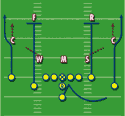 Diagram 6
Diagram 6 |
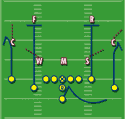 Diagram 7
Diagram 7 |
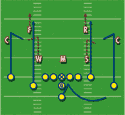 Diagram 8
Diagram 8 |
The next pattern in the series is a combination of the twelve yard
deep out route and option route (Diagram 7). Typically, as you will
see as we progress through the article, the #1 receivers show a
take off route on a number of the patterns. The out route becomes
an excellent throw after showing the four verticals and the option/vertical
combination. The out route will begin just as the take off route
did, ideally the defender would get out of his back pedal before
the break was made on the out so the defenders hips are turned and
he cannot make a play on the pass. The receiver will break to the
sideline at an angle that will bring him two yards closer to the
line of scrimmage. The quarterback will look for the loosest coverage
and best located flat defender. If the flat defender gets underneath
the out, the quarterback simply progresses to the option route filling
in the space vacated by the flat defender.
If the cornerbacks are playing an outside technique and the out
route is not a viable route, we will make a small adjustment to
the curl/flat combination to keep tight, aggressive safeties occupied
with a vertical push. #1 receivers will run a twelve yard curl route
with the #2 receivers running a seam pattern to control the safeties
(Diagram 8). The #1 receiver on the curl route will attack the defenders
leverage and make a sharp break at the proper depth and find the
throwing lane. Once again, if the defender over #2 becomes occupied
with his route, which will happen after hitting the option route
a few times, it leaves a throwing lane to the outside for the curl.
The running back will run a swing route after checking his protection
to still give the quarterback a curl/flat combination to that side
of the formation with a read off the flat defender. The quarterback
must make a quick decision and be able to release the ball as the
receiver is making his break on the curl to allow run after catch
yards. A second adjustment to this pattern will be to run all curls,
if the safeties are playing loose over the #2 receivers (Diagram
9). This creates a numbers advantage from a doubles formation, 4
on 3, for the offense versus the underneath coverage of a loose
quarters secondary. The quarterback is able to read the same flat
defender as in the seam/curl combination. This is especially good
versus defenders that will spot drop.
|
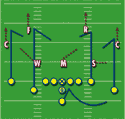
Diagram 9
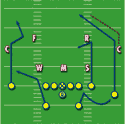
Diagram 10
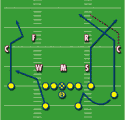
Diagram 11
|
The last of the vertical series patterns builds off the option and
curl pattern run by the #2 receiver in the previous three patterns.
The #1 receiver will run a post route breaking at ten to twelve
yards over top the #2 receiver running a curl route (Diagram 10).
If the safety is sitting at the ten to twelve yard area waiting
to cover the medium range patterns, he has to be taken advantage
of. The quarterback will read the safety over #2, if he sits, the
throw is to the post, if he drops, the ball goes to the curl.
The receiver on the curl route must be aware it is his responsibility
to get open versus the underneath coverage and give the quarterback
a throwing lane. This is also a good play action pattern. The single
receiver must occupy the safety to his side, with the knowledge
that he is attempting to get double covered. This receiver can run
a curl or post corner. The running back must be an option if the
safety drops to take the post and the underneath coverage falls
into the curl.
Once this pattern is seen by the defense and the cornerback dominates
the post route, the next step is to take the #2 receiver on a corner
route breaking at ten to twelve yards (Diagram 11). As in all the
previous routes discussed, on the corner route it is crucial for
the receiver to attack the defender with a three way go, stick the
route and make a sharp break for the corner. The quarterback will
read the cornerback, if he chases the post, the corner route by
#2 will be the throw.
With any offense that is going to rely on the pass, the quarterback
has to be drilled to be fundamentally sound enough to overcome the
pressures of the game and still perform the correct techniques.
These are three drills that are used to train the quarterback for
proper techniques in the pocket and are related to situations he
will see in every game.
The first drill is the progression drill. This drill will emphasize
the ability to stay in a proper passing position at all times while
the quarterback is working through his options on a given pattern.
Place five receivers five yards apart, ten yards from the quarterback.
The quarterback takes a five step drop, using proper drop mechanics,
and progresses from the first receiver on the right or left side
to the last receiver. He must make deliberate movements toward each
individual target, keeping the knees bent, taking small shuffle
steps, holding the ball in cocked position and keeping the hips
and shoulders in proper position to throw to the target he is looking
at.
A quarterback must be able to avoid the rush and still be focusing
down the field. The second drill is called dodge the pocket. One
quarterback will be facing two or three rushers on the line of scrimmage.
The quarterback will take a five step drop, after he hits his fifth
step, the rushers will come at the quarterback one after the other.
After the quarterback has dodged each of the rushers by sliding
to a side or forward, he will pass to a receiver down field. It
is critical for the quarterback to keep his body in a passing position,
with two hands on the ball and slide or step up in the pocket using
short, slide steps keeping proper balance.
A third drill also deals with pocket presence. The quarterback must
be able to step into a throw and take a hit from a defender. This
takes courage and repetition of keeping the eyes down field with
a rusher in his face. A defender with a hand shield or dummy will
align directly in front of the quarterback. The quarterback will
take a five step drop and as the quarterback is almost at the end
of his drop the defender will rush the quarterback. The quarterback
steps into his throw as the defender is hitting the quarterback
with the dummy.
I donít believe you need to very physical when hitting the
quarterback in this drill. The part of the game the quarterbacks
are getting accustomed to is the ability to keep his eyes downfield
with a rusher directly in his face and still stepping into throw
without short arming the pass. This drill can also be used in conjunction
with the dodge the pocket drill.
